Paxman (engines)
| Industry | Diesel engines brand |
|---|---|
| Founded | 1865 (1865) (as Davey, Paxman & Davey, Engineers) United Kingdom |
| Founders | James Noah Paxman Henry Charles Davey |
| Website | www.paxmanhistory.org.uk/paxrailt.htm |
Paxman is a major British brand of diesel engines. Ownership has changed on a number of occasions since the company's formation in 1865, and now the brand is owned by MAN SE, as part of MAN Diesel & Turbo. At its peak, the Paxman works covered 23 acres (9.3 ha) and employed over 2,000 people. Engine production is still primarily based at Paxman's Colchester works. Early Paxman diesel engines (with "Comet" indirect injection cylinder heads, designed by Sir Harry Ricardo) carried the name Paxman Ricardo.[1][2]
Contents
1 History
1.1 Davey Paxman
1.2 Ruston-Paxman
1.3 English Electric and GEC
1.4 Alsthom
1.5 MAN B&W Diesel
2 Diesel engines
2.1 Paxman
2.2 Ruston-Paxman
3 References
4 External links
History
Davey Paxman

DAVEY PAXMAN & Co Ltd ENGINEERS COLCHESTER ENGLAND 'portable' steam engine at Depot Monumentenhalle of Deutsches Technikmuseum Berlin

Stationary Davey-Paxman engine from the 1890s.

Detail view of same portable engine, showing Paxman builder's plate (dated 1921) on the regulator handle support above the firebox.

Northern Chief of the Romney, Hythe and Dymchurch Railway built in 1925
Paxman was founded by James Noah Paxman, Henry and Charles Davey as Davey, Paxman & Davey, Engineers in 1865, later Davey, Paxman & Co. which became a limited company in 1898. In 1920 the company became a member of the Agricultural & General Engineers Ltd (AGE) combine. In 1932 AGE collapsed and Paxman emerged as Davey Paxman & Co (Colchester) Ltd.[3]
Davey, Paxman and Davey conducted business as general engineers and ironworkers. The company manufactured steam engines, boilers, agricultural machinery, and mill gearing. By the early 1870s the company was supplying machinery to the Kimberley diamond mines in South Africa.
Ruston-Paxman
In 1940, Ruston & Hornsby Ltd purchased a controlling interest in the company; this co-operation led to the formation of Ruston-Paxman Group.
During World War II Paxman supplied diesel engines for various naval vessels such as e.g., the British U-class submarine and the British V-class submarine.
In 1954, the engine controls business of Paxman was reformed as a subsidiary, Ardleigh Engineering Ltd. In 1962, Paxman acquired the engine controls division of the Curtiss-Wright Corporation and merged the two businesses under the Regulateurs Europa name.
English Electric and GEC
In 1966, the Ruston-Paxman Group was acquired by English Electric. The diesel engine businesses were merged into English Electric Diesel Engines Ltd (later English Electric Diesels Ltd). Paxman became the "Paxman Engine Division" of English Electric. In 1968, English Electric was itself acquired by GEC. In 1972, GEC renamed the engines division GEC Diesels Limited. In 1975, a reorganisation saw the creation of Paxman Diesels Limited as a subsidiary.
Alsthom
In 1988, GEC merged its Paxman, Ruston and Mirrlees Blackstone diesels businesses with the Alsthom division of Compagnie Générale d'Electricité (CGE) to form GEC-Alsthom. Paxman became GEC ALSTHOM Paxman Diesels Ltd. In December 1997, GEC Alsthom had its initial public offering as Alstom. The diesel engine businesses became Alstom Engines Ltd (AEL).
MAN B&W Diesel
In 2000, Alstom Engines Ltd. was acquired by MAN B&W Diesel (a subsidiary of MAN AG) to become MAN B&W Diesel Ltd. In 2005, MAN sold the Regulateurs Europa controls business to Heinzmann GmbH.
Diesel engines
Paxman
Pre-1934 designs:[4]
- VZ, used in LMS 7054
Post-1934 designs (indirect injection):[5]
- RP, used in British Rail 10100, British Rail 10800, British Rail 11001, British Rail Class D2/1, British Rail Class 07, WAGR Y class, NSWGR 41 class
Hi-Dyne, a variant of the RPHXL using controlled turbocharging to provide a constant output power across the whole speed range.
Post-1952 designs (direct injection) [6]
- YH, used in British Rail Class 15 and British Rail Class 16
- ZH, used in British Rail Class 17
- YJ Ventura, used in Type 42 destroyer, British Rail Class 14, British Rail Class 29, British Rail Class 74
- Y3J (later RP200) Valenta, used in Type 22 frigate, Type 23 frigate, Invincible-class aircraft carrier, Upholder/Victoria-class submarine, InterCity 125 High Speed Train
- VP185, used in British Rail Class 43 (HST), New South Wales XPT
Ruston-Paxman
Examples of Ruston-Paxman diesel engines:
- RK3, used in British Rail Class 56, British Rail Class 58
References
^ "Anson Engine Museum Gallery - General - up to 2008/DSCF0050 renamed 28678". Enginemuseum.org. Retrieved 2017-05-26..mw-parser-output cite.citation{font-style:inherit}.mw-parser-output .citation q{quotes:"""""""'""'"}.mw-parser-output .citation .cs1-lock-free a{background:url("//upload.wikimedia.org/wikipedia/commons/thumb/6/65/Lock-green.svg/9px-Lock-green.svg.png")no-repeat;background-position:right .1em center}.mw-parser-output .citation .cs1-lock-limited a,.mw-parser-output .citation .cs1-lock-registration a{background:url("//upload.wikimedia.org/wikipedia/commons/thumb/d/d6/Lock-gray-alt-2.svg/9px-Lock-gray-alt-2.svg.png")no-repeat;background-position:right .1em center}.mw-parser-output .citation .cs1-lock-subscription a{background:url("//upload.wikimedia.org/wikipedia/commons/thumb/a/aa/Lock-red-alt-2.svg/9px-Lock-red-alt-2.svg.png")no-repeat;background-position:right .1em center}.mw-parser-output .cs1-subscription,.mw-parser-output .cs1-registration{color:#555}.mw-parser-output .cs1-subscription span,.mw-parser-output .cs1-registration span{border-bottom:1px dotted;cursor:help}.mw-parser-output .cs1-ws-icon a{background:url("//upload.wikimedia.org/wikipedia/commons/thumb/4/4c/Wikisource-logo.svg/12px-Wikisource-logo.svg.png")no-repeat;background-position:right .1em center}.mw-parser-output code.cs1-code{color:inherit;background:inherit;border:inherit;padding:inherit}.mw-parser-output .cs1-hidden-error{display:none;font-size:100%}.mw-parser-output .cs1-visible-error{font-size:100%}.mw-parser-output .cs1-maint{display:none;color:#33aa33;margin-left:0.3em}.mw-parser-output .cs1-subscription,.mw-parser-output .cs1-registration,.mw-parser-output .cs1-format{font-size:95%}.mw-parser-output .cs1-kern-left,.mw-parser-output .cs1-kern-wl-left{padding-left:0.2em}.mw-parser-output .cs1-kern-right,.mw-parser-output .cs1-kern-wl-right{padding-right:0.2em}
^ "Paxman History Pages - Paxman Diesel Engines Since 1934; Ricardo Comet Indirect Injection System". Paxmanhistory.org.uk. 2016-12-24. Retrieved 2017-05-26.
^ "History of Paxman's Ownership and Corporate Identity". Paxman History. Retrieved 2 March 2018.
^ "Paxman History Pages - Paxman Heavy Duty Diesel Engines". Paxmanhistory.org.uk. 2014-04-26. Retrieved 2017-05-26.
^ "Paxman History Pages - Paxman Diesel Engines Since 1934". Paxmanhistory.org.uk. 2016-12-24. Retrieved 2017-05-26.
^ "Paxman History Pages - Paxman Diesel Engines Since 1934: Direct Injection". Paxmanhistory.org.uk. 2016-12-24. Retrieved 2017-05-26.
External links
| Wikimedia Commons has media related to Davey, Paxman & Co.. |
- Paxman and Diesel Rail Traction
- Paxman engines since 1934